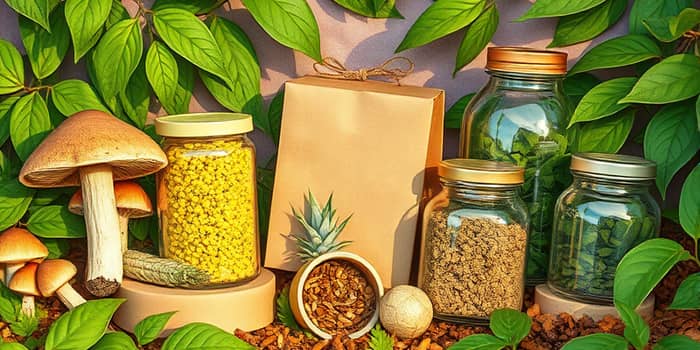
In an era marked by urgent environmental challenges and shifting consumer expectations, the packaging choices brands make today define their legacy tomorrow. From the grocer’s aisle to the digital cart, shoppers now demand more than convenience; they seek products wrapped in responsibility and innovation. This article explores the key trends reshaping modern packaging design and strategy, offering both inspiration and actionable steps for consumer goods companies ready to lead the sustainable revolution.
Consumers have made their voices heard: 61% prefer minimal packaging, 54% demand recyclable or compostable materials, and 53% expect significant reductions in plastic use. Beyond environmental concern, a remarkable 51% even prioritize packaging made from recycled content—a shift that reflects a growing willingness to reward brands with purpose.
For companies, this translates into more than marketing buzz. Sustainable packaging has become a competitive necessity, fueled by regulatory changes, industry standards, and the economic advantages of reduced material use and streamlined logistics.
Material science and creative design are unlocking a new frontier for packaging. Brands are embracing plant-based plastics and mushroom packaging, using seaweed-derived films and innovative starch blends that decompose without leaving harmful residues. Companies like Noodees lead with wood pulp that dissolves in water, proving that functionality can coexist with environmental responsibility.
Lightweighting remains a core strategy: by trimming excess volume and weight, brands achieve reduced transportation emissions and costs. These minimalist designs also resonate with eco-conscious shoppers who appreciate the straightforward aesthetic of less-is-more.
Smart packaging applications are emerging as a high-tech complement to material innovations. Integrated sensors and QR codes can inform consumers about recyclability, monitor freshness, and even guide proper disposal, fostering greater trust and engaging shoppers directly.
Leading consumer goods companies demonstrate that ambitious targets and concrete actions go hand in hand. Whether driven by internal goals or regulatory mandates, these brands showcase best practices for sustainable transitions.
These examples illustrate how setting ambitious sustainability goals drives innovation and aligns companies with consumer values, creating measurable environmental impact while reinforcing brand loyalty.
A circular economy approach reimagines packaging as an integral part of a product’s lifecycle. Instead of a linear “make-use-discard” model, companies design systems for collection, reuse, and recycling, closing the loop and maximizing resource efficiency.
By integrating circularity, brands not only reduce waste but also tap into new business models such as deposit-return schemes and subscription-based refill services. These strategies foster deeper customer engagement and open revenue streams beyond one-time purchases.
Transitioning to sustainable packaging can seem daunting, yet breaking it into strategic steps makes the process manageable. Begin with a comprehensive audit of current materials and suppliers to identify areas with the highest environmental impact. Engage cross-functional teams—R&D, marketing, supply chain, and procurement—to ensure alignment from ideation through implementation.
Next, pilot innovative materials on small product lines to test consumer feedback and operational feasibility. Leverage partnerships with startups and research institutions to access cutting-edge bio-materials and smart packaging technologies. Throughout these pilots, capture data on cost implications, carbon footprint reductions, and customer sentiment.
Finally, scale successful pilots business-wide, embedding sustainable packaging criteria into procurement and supplier contracts. Establish clear performance metrics—such as percentage of recycled content, weight reduction targets, and recyclability rates—and report progress transparently to build stakeholder trust and maintain internal momentum.
Brands must navigate cost pressures, supply chain complexities, and the risk of greenwashing. To mitigate these challenges:
Invest in long-term supplier relationships to secure steady access to high-quality sustainable materials. Develop robust lifecycle assessments to verify environmental claims and choose third-party certifications for credibility. Maintain open dialogue with regulators and industry peers to stay ahead of evolving standards and avoid costly rework.
By proactively addressing these hurdles, companies demonstrate genuine commitment to environmental stewardship, differentiating themselves in crowded markets and mitigating potential reputational risks.
Looking ahead, the landscape will continue to evolve. Emerging trends include advanced compostable materials engineered for industrial and home settings, packaging that actively purifies or extends product shelf life, and digital watermarking that streamlines sorting and recycling processes. As consumer education deepens, brands will play a critical role in guiding choices through transparent labeling and interactive tools.
Further, the convergence of sustainability and circular economy models will give rise to collaborative ecosystems, uniting manufacturers, retailers, recyclers, and civic organizations to build resilient packaging infrastructures that serve both planet and people.
The shift toward sustainable packaging is neither a fleeting trend nor a mere compliance exercise—it is a transformational imperative reshaping the future of consumer goods. By embracing innovation, fostering circularity, and committing to transparent progress, brands can lead with purpose and deliver products that resonate deeply with consumers’ values.
Every step toward lighter, compostable, or reusable packaging represents a powerful declaration: that business success and environmental responsibility are not mutually exclusive but deeply intertwined. As companies chart their path forward, they hold the potential to redefine industry norms and leave an indelible mark on global sustainability.
Let this moment be a testament to what is possible when ambition meets ingenuity, inspiring a new era of packaging that honors both people and the planet.
References













